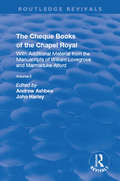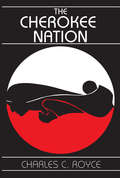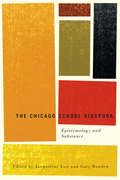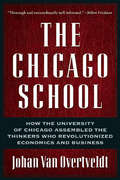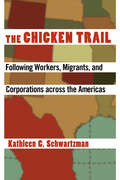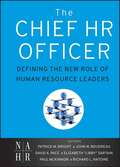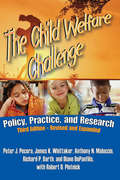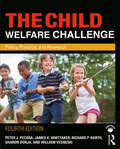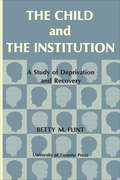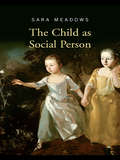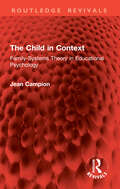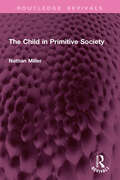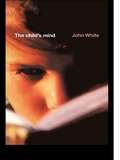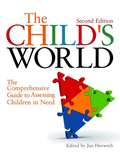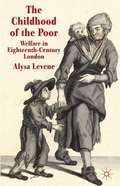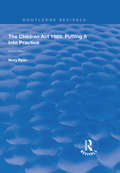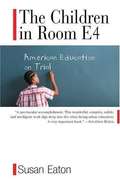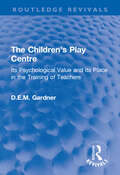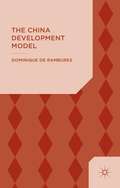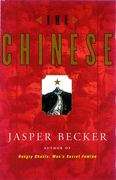- Table View
- List View
The Cheque Books of the Chapel Royal: With Additional Material from the Manuscripts of William Lovegrove and Marmaduke Alford
by Andrew Ashbee and John HarleyThis title was first published in 2000: The Chapel Royal holds a singular position in English ecclesiastical and musical life, as a body of priests and musicians appointed by and serving the personal religious needs of the sovereign. Its historical significance owes much to its location at a court which was, for many centuries, the centre of national power and culture. It was both an instrument and a visible manifestation of policy, and its history can be seen as reflecting the fortunes of government. While its origins are lost, its growth and membership become increasingly apparent from the 13th century and can be traced in detail from the 16th century. Chief among the documents which provide evidence of the Chapel's development and administration are the two surviving Cheque Books, preserved in the Archive of the Chapel Royal at St James's Palace. These cover a period from Queen Elizabeth I to Queen Victoria (with a few additional later entries). The "Old" Cheque Book has been widely used by scholars since an edition was published by Edward F. Rimbault in 1872.
The Cheque Books of the Chapel Royal: With Additional Material from the Manuscripts of William Lovegrove and Marmaduke Alford (Routledge Revivals)
by John Harley Andrew AshbeeThis title was first published in 2000: The Chapel Royal holds a singular position in English ecclesiastical and musical life, as a body of priests and musicians appointed by and serving the personal religious needs of the sovereign. Its historical significance owes much to its location at a court which was, for many centuries, the centre of national power and culture. It was both an instrument and a visible manifestation of policy, and its history can be seen as reflecting the fortunes of government. While its origins are lost, its growth and membership become increasingly apparent from the 13th century and can be traced in detail from the 16th century. Chief among the documents which provide evidence of the Chapel's development and administration are the two surviving Cheque Books, preserved in the Archive of the Chapel Royal at St James's Palace. These cover a period from Queen Elizabeth I to Queen Victoria (with a few additional later entries). The "Old" Cheque Book has been widely used by scholars since an edition was published by Edward F. Rimbault in 1872. The inadequacies of this edition have, however, long been recognized and this new transcription has now been prepared by Andrew Ashbee and John Harley, both of whom have worked previously on records of the English court and its musicians. They have aded transcriptions of the "New" Cheque Book and of the valuable personal memoranda compiled by William Lovegrove and Marmaduke Alford, respectively Serjeant and Yeoman of the Vestry of the Chapel Royal. The documents not only provide a register of the Chapel's personnel and their appointments, but reveal many of the day-to-day concerns of the group of men who formed the Chapel. Students of political and ecclesiastical history should find much to interest them in the details of the administration of this unique part of the royal household, while musical scholars should find valuable information about an institution whose traditions span several centuries and whose members have included Orlando Gibbons and William Boyce.
The Cherokee Nation
by Charles RoyceThis volume, presents the succession of treaties between 1785 and 1868 that reduced the holdings of the Cherokee Nation east of the Mississippi and culminated in their removal to Indian territory. Each document is accompanied by a detailed description of its antecedent conditions, the negotiations that led up to it, and its consequences. The events described here ended more than a century ago, but the motives and actions of the participants and the effects of the compromises and decisions they made are sadly familiar. The story presented here needs to be understood by everyone concerned with the survival of diverse ways of life and the quality of the relationships among peoples.The impersonal style of Royce's presentation enhances the poignancy of the Cherokee experience. Repeated declarations of peace and perpetual friendship contrast with repeated violations of treaties approved by Congress and the impotence of a people to defend their ancestral lands. The Cherokee "trail of broken treaties" has left us with a heritage of guilt and frustration that we have yet to overcome.The Native American Library, in which this volume appears, has been initiated by the National Anthropological Archives of the National Museum of Natural History, Smithsonian Institution, to publish original works by Indians and reprints selected by the tribes involved. Royce's work, which was included in the Fifth Annual Report of the Bureau of American Ethnology, is republished at the request of the Governing Body of the Cherokee Nation. The original text is prefaced by an evaluation of Royce and his work by Richard Mack Bettis and contains several illustrations not included in the earlier edition.
The Chicago School Diaspora
by Gary Bowden Jacqueline LowWhen the University of Chicago was founded in 1892 it established the first sociology department in the United States. The department grew rapidly in reputation and influence and by the 1920s graduates of its program were heading newly formed sociology programs across the country and determining the direction of the discipline and its future research. Their way of thinking about social relations revolutionized the social sciences by emphasizing an empirical approach to research, instead of the more philosophical "armchair" perspective that previously prevailed in American sociology. The Chicago School Diaspora presents work by Canadian and international scholars who identify with what they understand as the "Chicago School tradition." Broadly speaking, many of the scholars affiliated with sociology at Chicago understood human behaviour to be determined by social structures and environmental factors, rather than personal and biological characteristics. Contributors highlight key thinkers and epistemological issues associated with the Chicago School, as well as contemporary empirical research. Offering innovative theoretical explanations for the diversity and breadth of its scholarly traditions, The Chicago School Diaspora offers a fresh approach to ideas, topics, and approaches associated with the origins of North American sociology. Contributors include Michael Adorjan (University of Hong Kong, China), Gary Bowden (University of New Brunswick), Jeffrey Brown (University of New Brunswick), Tony Christensen (Wilfrid Laurier University), Luis Cisneros (postdoctoral scholar, University of Arizona), Gary A. Cook (Beloit College), Mary Jo Deegan (University of Nebraska-Lincoln), Scott Grills (Brandon University), Mervyn Horgan (Acadia University), Mark Hutter (Rowan University), Benjamin Kelly (Nipissing University), Rolf Lindner (Humboldt University & HafenCity University, Germany), Jacqueline Low (University of New Brunswick), Mourad Mjahed (Peace Corps, Rabat, Morocco), DeMond S. Miller (Rowan University), Edward Nell (New School for Social Research), David A. Nock (Lakehead University), Defne Över (PhD candidate, Cornell University), George Park (Memorial University), Thomas K. Park (University of Arizona), Dorothy Pawluch (McMaster University), Robert Prus (University of Waterloo), Antony J. Puddephatt (Lakehead University), Isher-Paul Sahni (Concordia University), Roger A. Salerno (Pace University), William Shaffir (McMaster University), Greg Smith (University of Salford, UK), Robert A. Stebbins (University of Calgary), Izabela Wagner (Warsaw University, Poland and CEMS EHESS - School for Advanced Studies in Social Sciences, France), and Yves Winkin (ENS Lyon, France).
The Chicago School Diaspora: Epistemology and Substance
by Gary Bowden Jacqueline LowWhen the University of Chicago was founded in 1892 it established the first sociology department in the United States. The department grew rapidly in reputation and influence and by the 1920s graduates of its program were heading newly formed sociology programs across the country and determining the direction of the discipline and its future research. Their way of thinking about social relations revolutionized the social sciences by emphasizing an empirical approach to research, instead of the more philosophical "armchair" perspective that previously prevailed in American sociology. The Chicago School Diaspora presents work by Canadian and international scholars who identify with what they understand as the "Chicago School tradition." Broadly speaking, many of the scholars affiliated with sociology at Chicago understood human behaviour to be determined by social structures and environmental factors, rather than personal and biological characteristics. Contributors highlight key thinkers and epistemological issues associated with the Chicago School, as well as contemporary empirical research. Offering innovative theoretical explanations for the diversity and breadth of its scholarly traditions, The Chicago School Diaspora offers a fresh approach to ideas, topics, and approaches associated with the origins of North American sociology. Contributors include Michael Adorjan (University of Hong Kong, China), Gary Bowden (University of New Brunswick), Jeffrey Brown (University of New Brunswick), Tony Christensen (Wilfrid Laurier University), Luis Cisneros (postdoctoral scholar, University of Arizona), Gary A. Cook (Beloit College), Mary Jo Deegan (University of Nebraska-Lincoln), Scott Grills (Brandon University), Mervyn Horgan (University of Guelph), Mark Hutter (Rowan University), Benjamin Kelly (Nipissing University), Rolf Lindner (Humboldt University & HafenCity University, Germany), Jacqueline Low (University of New Brunswick), Mourad Mjahed (Peace Corps, Rabat, Morocco), DeMond S. Miller (Rowan University), Edward Nell (New School for Social Research), David A. Nock (Lakehead University), Defne Över (PhD candidate, Cornell University), George Park (Memorial University), Thomas K. Park (University of Arizona), Dorothy Pawluch (McMaster University), Robert Prus (University of Waterloo), Antony J. Puddephatt (Lakehead University), Isher-Paul Sahni (Concordia University), Roger A. Salerno (Pace University), William Shaffir (McMaster University), Greg Smith (University of Salford, UK), Robert A. Stebbins (University of Calgary), Izabela Wagner (Warsaw University, Poland and CEMS EHESS - School for Advanced Studies in Social Sciences, France), and Yves Winkin (ENS Lyon, France).
The Chicago School: How the University of Chicago Assembled the Thinkers Who Revolutionized Economics and Business
by Johan Van OvertveldtThis “admirably detailed and thoroughly welcome history” provides a fascinating examination of a pivotal moment in the evolution of economic theory (The Economist).When Richard Nixon said “We are all Keynesians now” in 1971, few could have predicted that the next three decades would result in a complete transformation of the global economic landscape. The transformation was led by a small, relatively obscure group within the University of Chicago’s business school and its departments of economics and political science. These thinkers — including Milton Friedman, Gary Becker, George Stigler, Robert Lucas, and others — revolutionized economic orthodoxy in the second half of the 20th century, dominated the Nobel Prizes awarded in economics, and changed how business is done around the world.Written by a leading European economic thinker, The Chicago School is the first in-depth look at how this remarkable group came together. Exhaustively detailed, it provides a close recounting of the decade-by-decade progress of the Chicago School’s evolution. As such, it’s an essential contribution to the intellectual history of our time.
The Chicken Trail
by Kathleen C. SchwartzmanIn The Chicken Trail, Kathleen C. Schwartzman examines the impact of globalization-and of NAFTA in particular-on the North American poultry industry, focusing on the displacement of African American workers in the southeast United States and workers in Mexico. Schwartzman documents how the transformation of U.S. poultry production in the 1980s increased its export capacity and changed the nature and consequences of labor conflict. She documents how globalization-and NAFTA in particular-forced Mexico to open its commodity and capital markets, and eliminate state support of corporations and rural smallholders. As a consequence, many Mexicans were forced to abandon their no longer sustainable small farms, with some seeking work in industrialized poultry factories north of the border. By following this chicken trail, Schwartzman breaks through the deadlocked immigration debate, highlighting the broader economic and political contexts of immigration flows. The narrative that undocumented worker take jobs that Americans don't want to do is too simplistic. Schwartzman argues instead that illegal immigration is better understood as a labor story in which the hiring of undocumented workers is part of a management response to the crises of profit making and labor-management conflict. By placing the poultry industry at the center of a constellation of competing individual, corporate, and national interests and such factors as national debt, free trade, economic development, industrial restructuring, and African American unemployment, The Chicken Trail makes a significant contribution to our understanding of the implications of globalization for labor and how the externalities of free trade and neoliberalism become the social problems of nations and the tragedies of individuals.
The Chief HR Officer
by Libby Sartain Patrick M. Wright Paul Mckinnon John Boudreau David Pace Richard AntoinePraise for the chief HR Officer"The strategic portfolio of issues addressed and the sage wisdom and perspectives shared make this book a powerful transformation tool." -Jodee Kozlak, executive vice president, Human Resources, Target Corporation"An up-to-the-minute guide as to what is happening to the field of human resources through the eyes of those in charge of it." -Peter Cappelli, George W. Taylor Professor of Management and director, Center for Human Resources, Wharton School"This is a definitive guide for human resources leaders who are at the frontlines of competitiveness for their organizations." -David A. Rodriguez, executive vice president and chief human resources officer, Marriott International "This book is a must-read for all HR professionals to understand the evolution of how far we've come as a function and how much more we have to contribute to the success of the enterprise." -William J. Conaty, former senior vice president, Human Resources, General Electric Corporation"This book is a treasure-trove of insights that will elevate the practice of human resource management to a whole new level in the twenty-first century." -Lee D. Dyer, professor and chair, Department of Human Resource Studies, Cornell University"As a CEO who understands how important managing human capital is to delivering business results, The Chief HR Officer is an invaluable resource." -Russ Fradin, CEO, Hewitt Associations"This is a must-read for state-of-the-art in human resource management." -Scott A. Snell, E. Thayer Bigelow Professor of Business Administration, Darden Graduate School of Business, University of Virginia"This accessible, practical guide for HR professionals clearly describes the critical values, behaviors and skills needed to fulfill the multiple roles of an HR leader- trusted business partner, talent architect and expert functional leader."-Sally Bott, group human resource director, BP
The Chief Shepherdess: Lessons in Life, Love and Farming
by Zoe Colville‘Funny, gutsy and heartfelt.’ Daily MailZoë Colville spent years in a fancy hair salon with a long list of clients, living on cigarettes, croissants, and a shoestring. It was everything she'd ever wanted. But when an unexpected and overwhelming loss caused her life to shift unexpectedly, she found herself on a different path. One where the only use for a hairdryer is warming new-born lambs; where the cycle of life on a farm gives new meaning on purpose, and where nature is both a strict teacher and a balm to soothe the pressures of everyday life.Zoë is now a full-time farmer, business owner and activist. In this memoir, she speaks vivaciously, humorously, and candidly about the lessons learned along the way, from mental health, social media and identity to surviving as an entrepreneur in a shifting economy. And through those lessons - in love, loss, and lambing - discovering something even more important: that it's always the right time to take a bold step and try something new.'I grab the motionless lamb, which is frighteningly slippery, and scramble on my feet, swinging its little body around to help it breathe. I see its chest move, then it sneezes and starts breathing. It's stunned by the delivery experience. As am I. I'm high on adrenaline. Tears are streaming down my face. I pop the lamb down on the ground and start frantically rubbing its tiny body... Looking back, I can see that this was one of the first moments of questioning whether I'm truly cut out for farming, realising that the answer might be... yes!'
The Child Welfare Challenge: Policy, Practice, and Research
by Richard P. Barth Dianne DepanfilisWithin a historical and contemporary context, this book examines major policy practice and research issues as they jointly shape child welfare practice and its future. In addition to describing the major problems facing the field, the book highlights service innovations that have been developed in recent years. The resulting picture is encouraging, especially if certain major program reforms I are implemented and agencies are able to concentrate resources in a focused manner. The volume emphasizes families and children whose primary recourse to services has been through publicly funded child welfare agencies. The book considers historical areas of service—foster care and adoptions, in-home family-centered services, child-protective services, and residential services—where social work has an important role. Authors address the many fields of practice in which child and family services are provided or that involve substantial numbers of social work programs, such as services to adolescent parents, child mental health, education, and juvenile justice agencies. This new edition will continue to serve as a fundamen-tal introduction for new practitioners, as well as summary of recent developments for experienced practitioners.
The Child Welfare Challenge: Policy, Practice, and Research (Fourth Edition) (Modern Applications of Social Work Series)
by Richard Barth Peter Pecora James Whittaker Sharon Borja William Vesneski<p>Using both historical and contemporary contexts, The Child Welfare Challenge examines major policy practice and research issues as they jointly shape child welfare practice and its future. This text focuses on families and children whose primary recourse to services has been through publicly funded child welfare agencies, and considers historical areas of service—foster care and adoptions, in-home family-centered services, child-protective services, and residential services—where social work has an important role. <p>This fourth edition features new content on child maltreatment and prevention that is inspired by key conceptual frameworks, such as the World Health Organization social determinants of health paradigm, the CDC prevention taxonomy, and a protective factors ecological diagram published by the U.S. Children’s Bureau. This edition uses cross-sector data and more sophisticated predictive and other analytical processes to enhancing planning and practice design. The authors have streamlined content on child protective services (CPS) to allow for new chapters on juvenile justice/cross-over youth, and international innovations, as well as more content on biology and brain science. The fourth edition includes a glossary of terms as well as a companion website with instructor resources and pdfs of the book’s appendices.</p>
The Child and the Institution: A Study of Deprivation and Recovery
by Betty FlintIt has long been believed that children who must spend much of their lives in institutions inevitably develop personality deficiencies that make them liabilities to society. This book represents the first portion of a longitudinal study of the children of the Neil McNeil Home from infancy into adulthood. The study was begun in 1957 with a twofold purpose: first, to provide a therapeutic environment for children who had already suffered mental and emotional damage from an institutional milieu; and second, to devise methods of institutional care that would conduce to the normal development of children deprived of the usual supports of family relationships. The case histories presented here are interesting documents in themselves, but the book is more than a study of individual cases. It presents a detailed description of the process of creating in a child-care institution something of the atmosphere of a normal home. The conclusions reached depart in significant ways from former studies of institutionalized children, and will be of great importance and usefulness both to those who work professionally with children and to those concerned with the social future of children raised outside the family unit. The book was sponsored by the Institute of Child Study, University of Toronto.
The Child as Social Person
by Sara MeadowsQuestions about how children grow up in their social worlds are of enormous significance for parents, teachers, and society at large, as well as for children themselves. Clearly children are shaped by the social world that surrounds them but they also shape the social worlds that they, and those significant to them, encounter. But exactly how does this happen, and what can we do to ensure that it produces happy outcomes? This book provides a critical review of the psychological literature on the development of personality, social cognition, social skills, social relations and social outcomes from birth to early adulthood. It uses Bronfenbrenner's model of the development of the person and up-to-date evidence to analyse normal and abnormal social development, prosocial and antisocial behaviour, within and across cultures. As well as outlining the theory, the book addresses applied issues such as delinquency, school failure, and social exclusion. Using a coherent theoretical structure, The Child as Social Person examines material from across the biological and social sciences to present an integrated account of what we do and do not know about the development of the child as a social actor. The Child as Social Person provides an integrated overview of the exciting field of developmental social psychology, and as such will be essential reading for advanced undergraduate students in psychology, education and social work, as well as postgraduates and researchers in these disciplines.
The Child in Context: Family-Systems Theory in Educational Psychology (Routledge Revivals)
by Jean CampionFirst published in 1985, The Child in Context is the first to bring together the practice of educational psychology and the ‘family-systems’ theories regularly practised by psychologists, psychiatrists, and social workers in their attempt to understand the relationship between individuals and the social systems of which they are a part. The author, an educational psychologist herself, demonstrates how the educational psychologist can, in her efforts to help children who are failing in mainstream education, incorporate an understanding of family processes into her work with the child and his family. This integrative approach is also applied to the other system—the school—to which the child belongs, and to the interrelationship between different professionals involved in the management of the child.This book was written in the wake of the 1981 Education Act, at a time when educational psychologists were increasing their contact with parents. The discussion is illustrated with examples from the writer’s own experience with children of various ages and nationalities and covers a wide variety of behavioural and developmental difficulties.
The Child in Primitive Society (Routledge Revivals)
by Nathan MillerFirst published in 1928, The Child in Primitive Society examines the place of the child in the history of the less developed societies reaching back as close to social “origins” as is possible. The purpose here is not to enquire into the inner processes of learning, habit formation and acculturation in the child himself, but our aim is rather to examine the social milieu as it impinges upon the child- in other words, the customs and institutions which emerge as the educational systems of society later in the course of development. The purpose is to delineate the gradual trimming or fashioning of a child’s social existence by these social forces.The book discusses various important themes such as primitive notions of the child, the burden of children, the desire for children, infancy and childhood, primitive education, and inheritance and succession. This book is an important historical reference for scholars and researchers of sociology and education.
The Child's Mind
by John WhiteHow does a child's mind work? And what should parents know about it to help them in their daily interaction with children?This book is a fascinating, non-technical introduction to the mental life of the child. Written in a simple, accessible way for those without an academic background in philosophy, the book explores and explains key elements of the child's mind without overwhelming the reader with complicated theories. Some of the areas discussed are: how children learn concepts the acquisition of beliefs, skills, knowledge and understanding the place of memory can we teach thinking skills? what is intelligence? imagination and creativity the development of emotion connections between home life, education and the school curriculum.
The Child's World
by Edited by Jan HorwathThis new and updated edition of the best-selling book on assessing children in need and their families integrates practice, policy and theory to produce a comprehensive and multidisciplinary guide to all aspects of assessment. The Child's World not only provides an explanation of the Framework for the Assessment of Children in Need and their Families, but also offers a wealth of information on how to use it sensitively and effectively. The Child's World explores the implications of recent legislation, including the Children Act 2004, and national guidance for assessment practice. The contributors have drawn on the latest research, best practice and lessons learnt over the past decade of Framework implementation to equip practitioners, from different disciplines, to identify the developmental needs of children, assess parental capacity and evaluate the impact of family, economic and environmental factors on the carer's ability to meet the needs of the child. This book is essential reading for all practitioners, managers, trainers and educators in children's and adult services who use the Framework, and will also be a valued source of knowledge and guidance for those assessing children's needs in legislative contexts outside of England.
The Childhood of the Poor
by Alysa LeveneWas there a notion of childhood for the labouring classes, and was it distinctive from that of the elite? Examining pauper childhood, family life and societal reform, Levene asks whether new models of childhood in the eighteenth century affected the treatment of the young poor, and reveals how they and their families were helped through hard times.
The Children Act 1989: Putting it into Practice (Routledge Revivals)
by Mary RyanFirst published in 1999, this book provides a practical guide to those parts of the Children Act 1989 that relate to the provision of services by local authorities to children and families, dealing in particular with the powers and duties of local authorities in such circumstances, care and supervision proceedings and child protection issues. It combines a discussion of the legal framework of the Act and the regulations and guidance with information about good social work and legal practice, relevant research and recent case law. It is grounded on the author’s practical experience of providing an advice and advocacy service for families and training for social workers, lawyers and other child care professionals.
The Children in Child Health: Negotiating Young Lives and Health in New Zealand (Rutgers Series in Childhood Studies)
by Julie SprayWho are the children in child health policy? How do they live and see the world, and why should we know them? A journey into the lives of children coping in a world compromised by poverty and inequality, The Children in Child Health challenges the invisibility of children’s perspectives in health policy and argues that paying attention to what children do is critical for understanding the practical and policy implications of these experiences. In the unique context of indigenous Māori and migrant Pacific children in postcolonial New Zealand, Julie Spray explores the intertwining issues of epidemic disease, malnutrition, stress, violence, self-harm, and death to address the problem of how scholars and policy-makers alike can recognize and respond to children as social actors in their health. The Children in Child Health innovatively combines perspectives from childhood studies, medical anthropology, and public health and policy together with evocative ethnography to show how a deep understanding of children’s worlds can change our approach to their care.
The Children in Room E4: American Education on Trial
by Susan EatonThe story of a star student Jeremy, his friends and their teacher Luddy, who face great challenges in their school cut off from mainstream America also portrays the glaring truth of racial and economic divide found across the urban centres of America.
The Children of Immigrants at School: A Comparative Look at Integration in the United States and Western Europe
by Richard Alba and Jennifer HoldawayThe Children of Immigrants at School explores the 21st-century consequences of immigration through an examination of how the so-called second generation is faring educationally in six countries: France, Great Britain, the Netherlands, Spain, Sweden and the United States. In this insightful volume, Richard Alba and Jennifer Holdaway bring together a team of renowned social science researchers from around the globe to compare the educational achievements of children from low-status immigrant groups to those of mainstream populations in these countries, asking what we can learn from one system that can be usefully applied in another. Working from the results of a five-year, multi-national study, the contributors to The Children of Immigrants at School ultimately conclude that educational processes do, in fact, play a part in creating unequal status for immigrant groups in these societies. In most countries, the youth coming from the most numerous immigrant populations lag substantially behind their mainstream peers, implying that they will not be able to integrate economically and civically as traditional mainstream populations shrink. Despite this fact, the comparisons highlight features of each system that hinder the educational advance of immigrant-origin children, allowing the contributors to identify a number of policy solutions to help fix the problem. A comprehensive look at a growing global issue, The Children of Immigrants at School represents a major achievement in the fields of education and immigration studies.
The Children's Play Centre: Its Psychological Value and its Place in the Training of Teachers (Routledge Revivals)
by D.E.M. GardnerFirst published in 1937, The Children’s Play Centre is an account of Gardner’s Play Centre and her work in assessing its value in the education of children and the training of teachers. The book puts forward the value of play in the development of children and provides a detailed report of Gardner’s experiment. It also explores the significance of the Play Centre to the technique of training students. It will have lasting relevance for those interested in the history of education and the psychology of education.
The China Development Model
by Dominique De RamburesOver the last thirty years, China has been reforming its economy at breakneck speed. However a surge in nationalism is threatening China's relations with its neighbours and its rise to regional leadership. This book addresses a wide range of factors influencing the development of China's model and its influence on the rest of the world.
The Chinese
by Jasper BeckerThis is the hidden story of people of the world's largest nation--so poorly understood and so vital to the future. It exposes the Chinese society in all of its layers: from remote, illiterate peasants; to the rising classes of businessmen.

